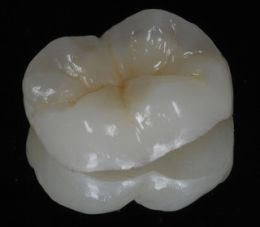Why would I need a crown?
Crowns are an ideal restoration for teeth that have been broken, or have been weakened by decay or a very large filling. A crown could be used for a number of other reasons, for instance:
- you may have discoloured fillings and would like to improve the appearance of the tooth
- you may have had a root filling which will need a crown to protect it
- it may help hold a bridge or denture firmly in place.
What is a post crown?
In root-filled teeth it may be necessary to insert a post before placing a crown. A post provides support and helps the crown stay in place. The weakened crown of the tooth may be shortened to gum level. A post can be made of prefabricated stainless steel which the dentist can fit directly into the root canal, or a custom-made post can be constructed by the dental technician to accurately fit the shape of the prepared root canal. The post is placed into the root canal and cemented in position, ready for the crown to be attached.
Are there any alternatives to post crowns for root-filled teeth?
If a root-filled tooth is not completely broken down, it may be possible to build it up again using filling material. This ‘core’ is then prepared in the same way as a natural tooth and the impressions are taken.
What is a crown made of?
Crowns can be made of a variety of different materials and new materials are continually being introduced. Some of the most popular options are listed below.
Porcelain bonded to precious metal: this is what most crowns are made from. A precious metal base is made and then porcelain is applied in layers over it.
Porcelain crowns: these crowns are made entirely out of porcelain and are not as strong as bonded crowns, but they can look very natural and are most often used for front teeth.
All-ceramic crowns: this modern technique offers a metal-free alternative, which can give the strength of a bonded crown and the appearance of a porcelain crown. Therefore it is suitable for use in all areas of the mouth.
Gold alloy crowns: gold is one of the oldest filling materials. Today it is used with other metal alloys to increase itsstrength, which makes it a very hardwearing restoration. These crowns are white or gold in colour.
How is the crown fitted?
When the dentist is happy with the fit and appearance of the new crown it will be fixed in place with special dental cement or adhesive. The cement forms a seal to hold the crown in place.
How long does the treatment take?
Traditionally, you would need to have at least two visits: the first for the preparation, impression, shade taking and fitting the temporary crown; and the second to fit the permanent crown but we can achieve all of this in just one visit with CEREC technology.
Does it hurt to have a tooth prepared for a crown?
No. A local anaesthetic is used and the preparation should feel no different from a filling. If the tooth does not have a nerve, and a post crown is being prepared, then a local anaesthetic may not be needed.
Will the crown be noticeable?
No. The crown will be made to match your other teeth exactly. The shade of the neighbouring teeth will be recorded, to make sure that the colour looks natural and matches the surrounding teeth.
Will the crown feel different?
Because the shape of the crown will be slightly different from the shape of your tooth before it was crowned, you may be aware of it to begin with. Within a few days it should feel fine, and you will not notice it. The crown may need some adjustment if your bite does not feel comfortable, so you should ask your dentist to check and adjust it.
How do I care for my crown?
How long your crown lasts depends on how well you look after it. The crown itself cannot decay, but decay can start where the edge of the crown where it joins the tooth. Therefore, it is important to keep this area just as clean as you would your natural teeth in order to prevent decay affecting the crown.
How long will the crown last?
Properly cared for crowns should last for many years. Your dentist will be able to tell you how long the crown may be expected to last.


